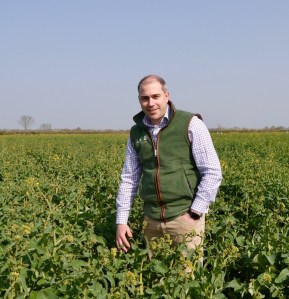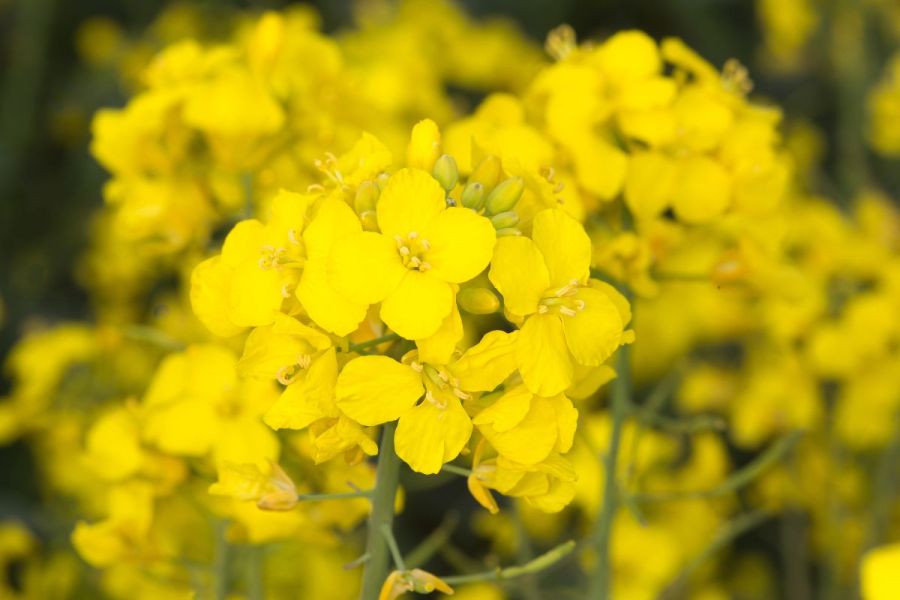Keeping stems healthy is vital for a successful oilseed rape crop. CPM explores how growers can get the best from their crops this season and beyond.
“The newer varieties coming through mean now growers don’t have to choose between yield and disease.”
By Charlotte Cunningham
Oilseed rape has been plagued with challenges over recent years, but with many now feeling more confident to grow the crop once again, managing risk at all points of the growing season is key to getting the most from the break crop.
Taking stock of crops currently in the ground, Frontier’s Chris Piggott says things are generally looking positive. “Where crops have established well and had enough rain, they’re looking really good. That said, we’ve had reports of failed crops in some of the drier regions, into East Anglia, and we’ve had a lot of extreme weather so far this season. But after a difficult few years, there are some really good-looking crops, which is great to see, and there is a lot more positivity around the crop generally.”
Though crops are largely looking well to date, in a recent survey carried out by CPM and LSPB, 61% of growers revealed that cabbage stem flea beetle remains the biggest risk to their current OSR crops. Regionality comes into this, says Chris Piggott, with the majority of respondents to the survey residing in the East Midlands, Yorkshire and the Humber and the East of England. “We know the East of England and the South East is where we’ve had a lot of severe flea beetle issues and it has affected these areas a lot more than others.”
The weather also poses a significant risk to growers, but despite some harsh temperatures over the recent months, the survey revealed that the majority of growers had lost 1-25% of cropping to date.
Alongside the mouth of the mighty beetle and the effects of Mother Nature, compromised stem health is another risk to growers. Disease can hugely impact this, and according to 45% of respondents phoma (stem canker) is the most important disease on their farm, followed by light leaf spot (29%).
With regards to stem health and the severity phoma burdens have on this, it’s no surprise that it’s a key concern for many growers, says SRUC’s Fiona Burnett. “Phoma can produce major cankers in the stem which can really hit yield. In worse case scenarios, you can easily lose 1t/ha in yield, and losses of 0.5t/ha are fairly typical in regions where it is an issue.”
As well as the cost of lost yield, severe phoma can also drive crop protection spend, she adds. “At the top level, you might be looking at two or three sprays for phoma. So that’s a pretty significant investment in a crop that can be marginal.”
As severe as the problem is, Chris Piggott says phoma presence and severity can vary by region. “Phoma has generally been the most visible disease on OSR crops, which is perhaps a reason why so many growers are looking at it so closely. However, it has largely been a southern problem, and light leaf spot more common in the north, so it’s quite a surprise to see phoma right at the top when many respondents were from those northern and eastern regions of England.”
For growers in high-risk light leaf spot areas, this is often an endemic challenge and requires multiple treatments a year, adds Fiona. “While the products do something, it remains a problem within crops, meaning it’s important to look at other control strategies.”
Adopting a holistic approach to disease control has proven for many growers to be the most successful strategy, rather than relying purely on fungicides, and when it comes to phoma control, over half of growers (54%) said that variety selection is the most effective method.
“There is some really good inherent resistance against phoma within varieties,” says Chris Piggott. “So while it’s a very important disease, the ability to harness this resistance from the get-go makes the control strategy not particularly challenging.”
He adds that hybrid rape in particular offers some really high resistance scores. “We’ve had the Rlm7 gene for quite some time, but if we look at the capabilities of LSPB’s new RlmS gene, this improves control even further.”

Chris Guest says the launch of the new RlmS gene gives growers access to a new set of genetics to help manage phoma resistance.
According to LSPB’s Chris Guest, the launch of the new RlmS gene gives growers access to a new set of genetics to help manage phoma resistance. “It’s important to stress that RlmS is an alternative – not a direct replacement. For the longevity of traditional genes like Rlm7, it’s vital that we don’t just rely on single sets of genes and varieties.”
The gene currently features in four LSPB varieties – Respect, Flemming, Murray, and Vegas – which also boast high yields and good light leaf spot scores, he adds.
The unique phoma resistance is also associated with strong overall plant health, and the gene has especially good stem resistance that brings better protection against verticillium and sclerotinia pathogens, notes Chris Guest.
Variety selection was also pegged the most effective method for controlling light leaf spot, according to 45% of growers. “Scores for diseases like leaf spot, particularly within hybrid types, are just getting better so it’s vital to make the most of this acceleration in breeding as part of the control strategy,” says Chris Piggott.
Fiona adds: “We haven’t had any varieties with scores of 3 or 4 for light leaf spot for years now. Virtually no one is growing OSR with a score of less than 5, which has probably helped with control, particularly as it’s a disease that moves around in the air at harvest time to reinfect new crops.”

Chris Piggott believes that the presence of disease could be limiting genetic yield potential in some of the high-yielding types, so it’s important to find balance between the two when selecting varieties.
Though variety selection is a vital first line of defence, fungicide control is also important – particularly in a season like the current one where light leaf spot risk is high, warns Chris Guest. “Good genetics should be backed up with effective products and with these damp, mild conditions it’s an incubator for light leaf spot to spread rapidly through the canopy. What we don’t want is to allow the pathogen to evolve against the inherent resistance brought in by genetics, so it’s important we control it throughout crop growth with good chemistry.”
When it comes to verticillium control, rotational frequency is the most effective control strategy according to 43% of growers, followed by variety selection (29%). “Variety selection is a difficult one with verticillium as there aren’t any official scores for it,” believes Fiona. “I know breeders are working on varieties that might have better resilience than others, but at the moment, there isn’t much officially to guide growers.”
That said, Chris Guest says that it’s important to select the right variety if verticillium is an issue on farm as there can be quite significant variations in the level of resistance. He adds that AHDB is looking to begin publishing ratings in next season’s RL which could help provide better guidance in the future.
Though verticillium wasn’t seen as a key priority for the growers surveyed, with just 7% saying it’s their most important disease, Chris Piggott warns that it could be something that farmers are not looking closely enough at and as such, keeping an eye on it – even if it hasn’t traditionally been a major problem – is important. “Verticillium is something that is probably having a bigger impact on OSR yield than we realise.”

In worst case scenarios, phoma could see growers lose 1t/ha in yield, says Fiona Burnett.
Chris Guest concurs and adds: “Given that many respondents were from more eastern regions, it’s quite concerning to see that verticillium was flagged as the least important disease. Particularly from a late season disease pressure perspective, we’re seeing that it’s actually having quite a big impact on yield. Verticillium ought to be higher up the priority list, certainly in the eastern counties where a short rotation, direct drilled/min-til establishment system is in place.”
While variety selection is the “quickest and easiest” tool for growers to pick up when it comes to disease resistance across the board, Fiona warns that the importance of rotational frequency shouldn’t be overlooked. “All of these diseases are driven by tight rotations, so really, the presence of disease should be the barometer for how well your rotation is working – or not. Looking at a disease like verticillium, its impact can last for 10 years so even nudging your rotation out by a year could make a big difference.”
Despite the importance of variety choice, when it comes down to selecting individual varieties yield is still king according to 53% of growers who said it’s their most important characteristic, followed by disease resistance score (31%). So how can growers strike the right balance between maximising output and protecting crops from yield-robbing diseases?
“The newer varieties coming through now mean growers don’t have to choose between yield and disease anymore – previously, high disease ratings often came at a penalty,” says Fiona. “Now, it’s more a case of just making slight compromises on a few percentage points of yield. There are now also many more options on the AHDB Recommended List with regards to high resistance varieties, meaning growers have greater choice than ever before. We’re now almost at the point where we can have our cake and eat it.”
Chris Guest says that LSPB’s varieties Murray and Vegas are an example of this. “Their agronomic merit scores are very strong, as is their yield, so it helps give growers a little bit more security.”
Chris Piggott adds: “Yield has got to be up there in terms of the decision-maker – that’s what pays at the end of the day. But from my perspective, I believe that disease could be limiting genetic yield potential, so it’s important to find balance between the two when selecting varieties. Variety choice is much more than just out-and-out yield.”
This article was taken from the latest issue of CPM. Read the article in full here.
For more articles like this, subscribe here.
Sign up for Crop Production Magazine’s FREE e-newsletter here.




